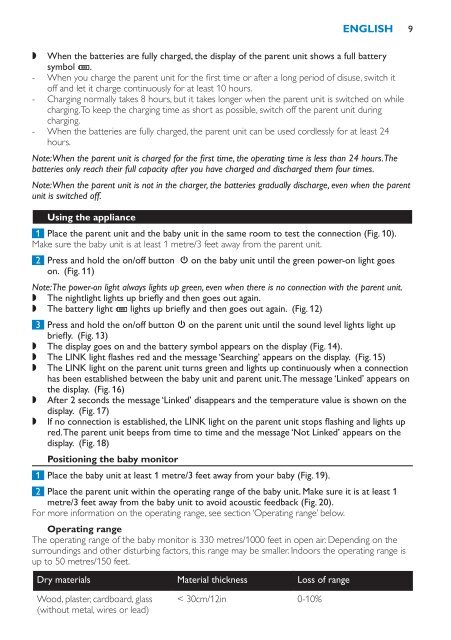Philips Avent DECT baby monitor - User manual - BUL
Philips Avent DECT baby monitor - User manual - BUL
Philips Avent DECT baby monitor - User manual - BUL
Create successful ePaper yourself
Turn your PDF publications into a flip-book with our unique Google optimized e-Paper software.
English 9<br />
,,<br />
When the batteries are fully charged, the display of the parent unit shows a full battery<br />
symbol T.<br />
--<br />
When you charge the parent unit for the first time or after a long period of disuse, switch it<br />
off and let it charge continuously for at least 10 hours.<br />
--<br />
Charging normally takes 8 hours, but it takes longer when the parent unit is switched on while<br />
charging. To keep the charging time as short as possible, switch off the parent unit during<br />
charging.<br />
--<br />
When the batteries are fully charged, the parent unit can be used cordlessly for at least 24<br />
hours.<br />
Note: When the parent unit is charged for the first time, the operating time is less than 24 hours. The<br />
batteries only reach their full capacity after you have charged and discharged them four times.<br />
Note: When the parent unit is not in the charger, the batteries gradually discharge, even when the parent<br />
unit is switched off.<br />
Using the appliance<br />
1 Place the parent unit and the <strong>baby</strong> unit in the same room to test the connection (Fig. 10).<br />
Make sure the <strong>baby</strong> unit is at least 1 metre/3 feet away from the parent unit.<br />
2 Press and hold the on/off button 3 on the <strong>baby</strong> unit until the green power-on light goes<br />
on. (Fig. 11)<br />
Note: The power-on light always lights up green, even when there is no connection with the parent unit.<br />
,,<br />
The nightlight lights up briefly and then goes out again.<br />
,,<br />
The battery light T lights up briefly and then goes out again. (Fig. 12)<br />
3 Press and hold the on/off button 3 on the parent unit until the sound level lights light up<br />
briefly. (Fig. 13)<br />
,,<br />
The display goes on and the battery symbol appears on the display (Fig. 14).<br />
,,<br />
The LINK light flashes red and the message ‘Searching’ appears on the display. (Fig. 15)<br />
,,<br />
The LINK light on the parent unit turns green and lights up continuously when a connection<br />
has been established between the <strong>baby</strong> unit and parent unit. The message ‘Linked’ appears on<br />
the display. (Fig. 16)<br />
,,<br />
After 2 seconds the message ‘Linked’ disappears and the temperature value is shown on the<br />
display. (Fig. 17)<br />
,,<br />
If no connection is established, the LINK light on the parent unit stops flashing and lights up<br />
red. The parent unit beeps from time to time and the message ‘Not Linked’ appears on the<br />
display. (Fig. 18)<br />
Positioning the <strong>baby</strong> <strong>monitor</strong><br />
1 Place the <strong>baby</strong> unit at least 1 metre/3 feet away from your <strong>baby</strong> (Fig. 19).<br />
2 Place the parent unit within the operating range of the <strong>baby</strong> unit. Make sure it is at least 1<br />
metre/3 feet away from the <strong>baby</strong> unit to avoid acoustic feedback (Fig. 20).<br />
For more information on the operating range, see section ‘Operating range’ below.<br />
Operating range<br />
The operating range of the <strong>baby</strong> <strong>monitor</strong> is 330 metres/1000 feet in open air. Depending on the<br />
surroundings and other disturbing factors, this range may be smaller. Indoors the operating range is<br />
up to 50 metres/150 feet.<br />
Dry materials Material thickness Loss of range<br />
Wood, plaster, cardboard, glass<br />
(without metal, wires or lead)<br />
< 30cm/12in 0-10%
















